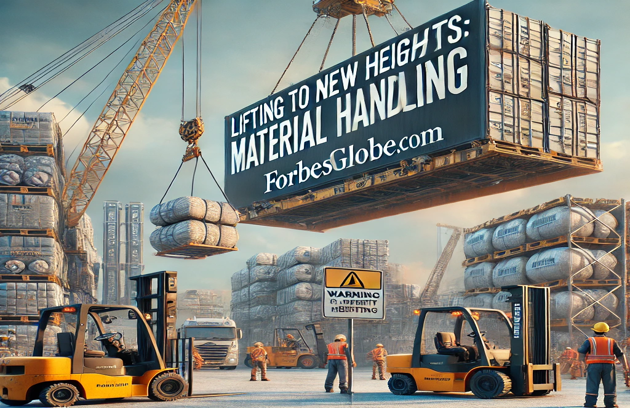In the realm of industrial operations, material handling plays a crucial role in dictating the overall efficiency and productivity of a facility. If you want to handle materials safely and effectively, you need a plan and tools made for the job. The material handling field is always changing as technology advances and industry standards change, forcing businesses to keep up to ensure they possess a competitive edge. One of the most critical components in this field is lifting equipment, which allows for the movement, protection, storage, and control of materials throughout the manufacturing and distribution process.
Understanding Material Handling
Material handling is a set of activities related to moving, protecting, storing, and controlling materials and products in haulage, warehousing, distribution, consumption, and disposal. It is a broad term that encompasses everything from the beginning planning stages to the equipment used and the techniques used to transport goods seamlessly and safely. An efficient material handling system helps reduce costs, improve workflow, and increase productivity.
Importance of Efficient Material Handling
Advanced material handling optimizes the process, bringing many advantages, such as increased safety in the workplace, decreased damage to the goods, smoother product flow, and reduced operational costs. A good system reduces unnecessary movement, prevents bottlenecks, and optimizes operations. It also directly affects customer satisfaction, making sure deliveries are timely and accurate, which in turn creates a company’s reputation and potential for future business.
Assessing the Right Lifting Equipment
Choosing the right lifting equipment is essential to material handling mastery. Whatever equipment is selected must be done according to the IRM; i.e., the characteristics of the materials that need to be dealt with, the layout of the premises, and the terms of the handling operation must be kept in mind. Forklifts, cranes, hoists, and automated robotic systems are among the top lifting equipment types available in the market, catering to different applications and work environments.
Warehousing and Storage Solutions
Material handling systems consist of essential components such as storage and warehousing. They are concerned with the secure storage of goods that preserves their quality and condition, allowing convenient access to further processing or sending. The storage spaces have a significant role to play with the help of lifting equipment such as stackers, pallet trucks, and reach trucks for manoeuvring goods.
Training and Safety Measures
Material handling is all about training and safety. Workers must be sufficiently trained on any equipment they’re using, and safety precautions need to be followed to prevent workplace accidents. Regular maintenance of heavy equipment and machinery means they are working effectively and safely and helps prevent machinery failures and costly downtime.
Technological Integration in Material Handling
Automation and AI-driven equipment are revolutionizing the material handling industry. These advancements promise increased productivity, improved space utilization, and elimination of human error. But technology needs to be integrated in a way that preserves human domain knowledge, and it needs to fit naturally into existing workflows.
The Role of Ergonomics
Material handling ergonomics ensures that these tasks are performed in a way that minimises physical strain on workers. Well-designed lifting equipment and workplace layouts that consider ergonomic considerations are essential in reducing the risk of injury and improving work practices and productivity.
Environmental Considerations
The environmental impact of their operations is something the businesses of today can no longer afford to overlook. Implementing sustainable material handling practices is critical to helping the ecosystem, but it also shines a good light on the company, reducing overall costs. Energy-saving lifting equipment, recycling schemes, and sustainable packaging are just some of the ways businesses are boosting their green credentials.
Investing in Quality Lifting Equipment
Investment in quality lifting equipment can provide significant returns for businesses. High-quality equipment is generally more reliable, lasts longer, and requires less maintenance. This not only means a better bottom line but also ensures compliance with safety regulations and industry standards.
Optimising Layout for Material Flow
The layout of a facility must be optimized for material flow to facilitate efficient handling. This involves planning clear pathways for the movement of goods, strategically placing equipment, and considering the most effective storage solutions. The optimization of space is an ongoing process that can result in substantial productivity gains.
Fostering a Culture of Continuous Improvement
A culture of continuous improvement in material handling allows businesses to keep pace with changes in the industry and technologies. Regular reviews, employee feedback, and the monitoring of key performance indicators are essential to this culture, leading to ongoing enhancements in the handling process.
Maximising Investment Through Maintenance and Upkeep
However, proper maintenance and upgradation of lifting equipment ensure that the money spent on material handling produces the best possible outcome. Routine maintenance prolongs the life of the equipment and helps it run better. Upgrades may also be needed to comply with new safety standards or implement newer technologies.
Final Thoughts
Material handling lifts to new heights, discovering the link between practices, equipment, and continuous improvement. This mastery leads to operational excellence that makes businesses competitive in the ever-evolving industrial marketplace. A commitment to quality in the selection of lifting equipment, together with effective training, safety, and tech advances, lays the groundwork for material handling success.
Empowering Material Handling Excellence
In conclusion, mastering material handling is essential for businesses looking to scale their operations effectively. It is an intricate yet critical component of a company’s infrastructure, requiring deliberate strategies and appropriate investments in equipment and personnel training. In doing so, businesses can elevate their logistical capabilities and truly lift their operations to new heights.
Also Read:


